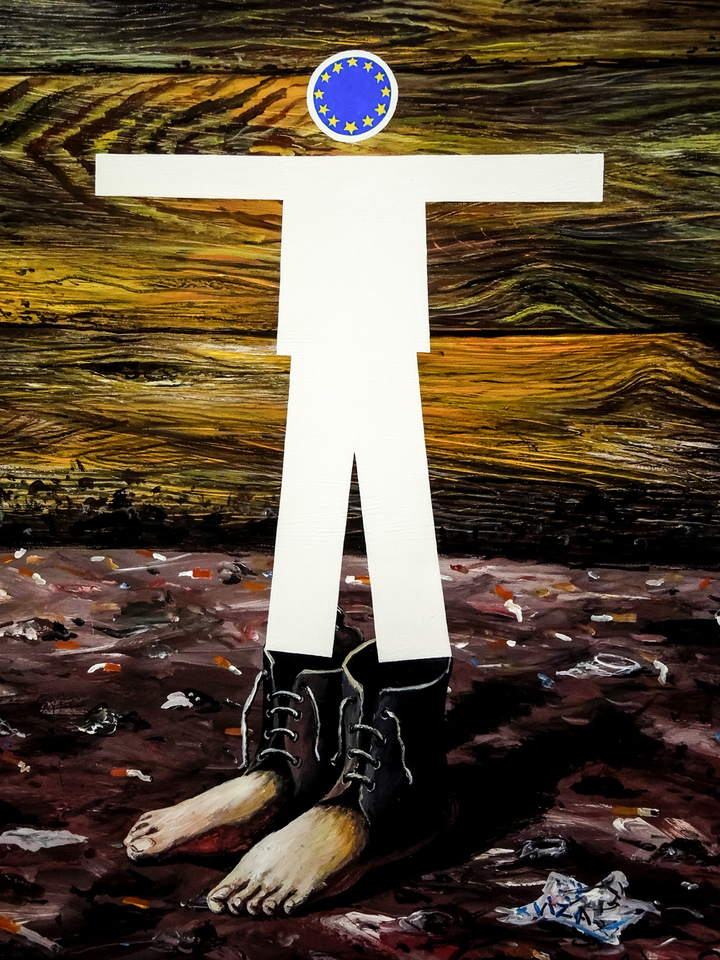Artist Igor Novikov spoke about the energy that fuels Russia
[ad_1]
On April 2, an exhibition by Igor Novikov, called “Hierotopy,” opened at the capital’s Museum of Nonconformism/Gallery of Nadya Brykina. The MK correspondent was one of the first to see it and concluded that if poetry is the best words in the best order, then the artist’s exhibition is famous works in a different order and in combination with new works.
The earliest of Novikov’s paintings included in the project dates back to 1985. “Alone with the Jungle” is from 1987, there are several films from 1990–1991. In the late 80s, Novikov made a lot of Soviet-American works: for that time it was both a kind of game and a tribute to the trend. I remember that we even issued a disarmament coin in 1988 with a double denomination of one ruble/one dollar. So the artist gives us a kind of dual world, reminiscent of the merging of the Outer World and the Earthly Kingdom in the Mortal Kombat Universe.
This is when we see the Spasskaya Tower on the left, and the Central Station of New York and the Chrysler Building on the right, and they are connected by Novikov’s signature pictogram men, the two of them riding on a swing-balance beam. A modification of this plot is the most flashy child of perestroika, “Russian Swings. Genesis” in 1989, where the White House and the lawn in front of it simultaneously exist, plus the Kremlin with the dome of the Senate Palace topped with a red flag.
The starting messages of Novikov’s creative path had to be described in such detail because the recently created “The Rape of Europe. Prima donna” touches on the Western Russian theme, but only now the white figurine-sign with the flag of the European Union on its head is wearing holey boots, its huge feet stand on the ground spit on and covered with cigarette butts, and whose land this is – Russian or Anglo-Saxon – does not matter , the task was to articulate the crisis in culture, the dehumanization of art and the “Decline of Europe” that frightened us a hundred years ago, but which became a reality only in the 21st century.

Another Eurocentric canvas is also a recent one; I won’t give the name in Latin, but the gist is this: a landscape a la the Swiss Alps, a lake, a piece of wood for tourists, and just around the corner is not the happiness that the Bolsheviks had long promised us, but red figures surrounded by soaring Swiss bank logos. In general, the power of the Golden Calf, but in its modern interpretation.
What does “Hierotopy” have to do with it? To begin with, let’s explain the term itself – it is derived from two Greek words “sacred” (“hieros” – the root is the same as in the word “priest”) and “topos”, in fact, “place”, “location”. There is no clear answer to the question of which place is sacred in nature for Novikov, but painting is not composing hymns or inventing slogans.
But from his words spoken at the opening, it becomes clear why he loves to organize exhibitions in Russian regions.
“Here, in Russia, you receive light and pour it out into paintings… I lived abroad and felt there that I was losing this energy. Thanks to our people for giving it,” admitted Novikov.
The artist directly addresses the sacred theme, offering his version of the engraving “The Abbot and Death” by Hans Holbein (the younger), created in the first half of the 16th century. But only it is supplemented with a “lying” pictogram of a drunkard with a bottle and a flying Russian fighter in the sky.
The fact that the aircraft is domestic, and not, say, a Phantom Douglas, is another Novikov trademark. Even if he chose as a background or background image not a Levitan landscape or something recognizable as Russian, “ours” still dominates the “world”. In the depiction of Jesus Christ there are African Orthodox, Catholic Western traditions, ecclesiastical and secular, religious and atheistic, whatever.
But Igor Novikov enters into a dialogue with Kramskoy’s “Christ in the Desert,” naturally offering a re-interpretation – with a drawn smoking chimney and little men holding torches in their hands, stylized as the logo of a Russian gas producing concern. And if he is a postmodernist, then he has a Russian soul. It is obvious.
Newspaper headline:
The European Union in tattered boots
[ad_2]
Source link






